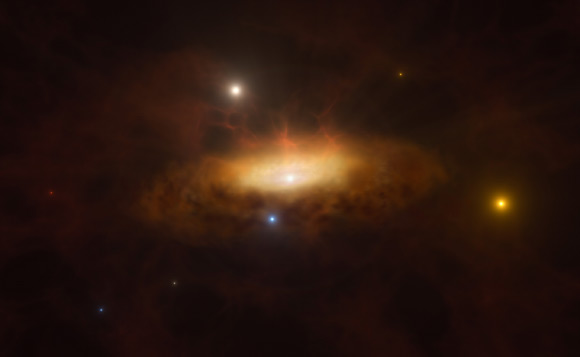In December 2019, SDSS 1335+0728 — a little-known galaxy located 300 million light-years away in the constellation of Virgo — suddenly started shining brighter than ever before. To understand why, astronomers have used data from several space and ground-based observatories to track how the galaxy’s brightness has varied. They conclude that they are witnessing the result of the sudden awakening of the central supermassive black hole.

This artist’s impression shows the growing disk of material being pulled in by the black hole as it feeds on the gas available in its surroundings, making the galaxy light up. Image credit: ESO / M. Kornmesser.
“Imagine you’ve been observing a distant galaxy for years, and it always seemed calm and inactive,” said Dr. Paula Sánchez Sáez, an astronomer at ESO and the Millennium Institute of Astrophysics.
“Suddenly, its core starts showing dramatic changes in brightness, unlike any typical events we’ve seen before.”
This is what happened to SDSS 1335+0728, which is now classified as having an active galactic nucleus (AGN) after it brightened dramatically in December 2019.
Some phenomena, like supernova explosions or tidal disruption events can make galaxies suddenly light up. But these brightness variations typically last only a few dozen or, at most, a few hundreds of days.
SDSS 1335+0728 is still growing brighter today, more than four years after it was first seen to ‘switch on.’
Moreover, the variations detected in the galaxy are unlike any seen before, pointing astronomers towards a different explanation.
Dr. Sáez and colleagues tried to understand these brightness variations using a combination of archival data and new observations from several facilities, including the X-SHOOTER instrument on ESO’s Very Large Telescope.
Comparing the data taken before and after December 2019, they found that SDSS 1335+0728 is now radiating much more light at ultraviolet, optical, and infrared wavelengths. The galaxy also started emitting X-rays in February 2024.
“This behavior is unprecedented,” Dr. Sáez said.
“The most tangible option to explain this phenomenon is that we are seeing how the core of the galaxy is beginning to show activity,” added Dr. Lorena Hernández García, an astronomer at the Millennium Institute of Astrophysics and the University of Valparaíso.
“If so, this would be the first time that we see the activation of a massive black hole in real time.”
“Supermassive black holes usually are sleeping and not directly visible,” said Dr. Claudio Ricci, an astronomer with the Diego Portales University and the Kavli Institute for Astronomy and Astrophysics at Peking University.
“In the case of SDSS 1335+0728, we were able to observe the awakening of the massive black hole, which suddenly started to feast on gas available in its surroundings, becoming very bright.”
“This process has never been observed before,” Dr. García said.
“Previous studies reported inactive galaxies becoming active after several years, but this is the first time the process itself — the awakening of the black hole — has been observed in real time.”
“This is something that could happen also to our own Sagittarius A*, a supermassive black hole located at the center of our Milky Way Galaxy, but it is unclear how likely this is to happen.”
“Regardless of the nature of the variations, SDSS 1335+0728 provides valuable information on how black holes grow and evolve,” Dr. Sáez said.
“We expect that instruments like MUSE on the VLT or those on the upcoming Extremely Large Telescope (ELT) will be key in understanding why the galaxy is brightening.”
The study will be published in the journal Astronomy & Astrophysics.
_____
P. S’anchez-‘aez et al. 2024. SDSS1335+0728: The awakening of a ~106 M_sun black hole. A&A, in press; doi: 10.1051/0004-6361/202347957
>>> Read full article>>>
Copyright for syndicated content belongs to the linked Source : Breaking Science News – https://www.sci.news/astronomy/supermassive-black-hole-awakening-13028.html


















![[News] Japan Develops 10nm Nanoimprint Technology, with Potential to Tackle EUV Bottleneck – TrendForce](https://earth-news.info/wp-content/uploads/2025/12/329851-news-japan-develops-10nm-nanoimprint-technology-with-potential-to-tackle-euv-bottleneck-trendforce-360x180.jpg)











